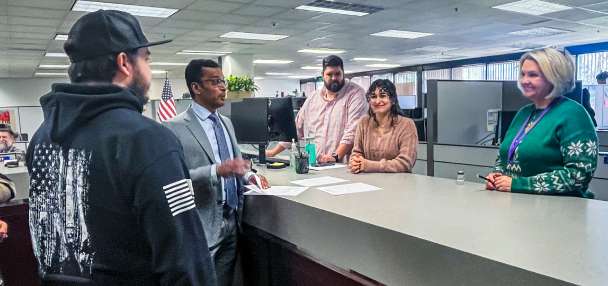Estimated read time: 7-8 minutes
- A KSL investigation reveals listed reasons for seclusion of students.
- Disruption cited in 46.7% of cases; new law restricts seclusion use.
- Parents question seclusion's impact, advocate for alternative behavioral management methods.
PROVO — On his first day of third grade, Mark Stovall spent most of his school hours in seclusion.
John and Dakin Stovall transferred their 8-year-old to Amelia Earhart Elementary in Provo in the fall of 2023.
Dakin Stovall said Mark has big feelings and his autism allows him to feel things differently.
"He's like the first one in the family to notice if I'm having a hard day," Dakin Stovall said.

But Mark, now 9 years old, said sometimes the feelings can be "bad." He calls it "nightmare mode" and said when he got into that mode at Amelia Earhart Elementary, he was put in the timeout room.
School records show that on the first day of school, he was put in the room at least eight times between 10:59 a.m. and 2:52 p.m. However, his mother showed KSL a text she received earlier in the day stating he was already in seclusion around 10:30 a.m.
Over the next five months, the school documented secluding Mark at least 20 times, sometimes several times in a single day.
While the school records do not state the direct reason for Mark's seclusion, they do list behaviors, including hitting or biting staff, tipping tables, tearing paper and refusing to do work.
That range raised questions for Mark's parents.
"It wasn't always clear like, what the line was about. What is too unsafe," John Stovall said.
Amelia Earhart Elementary's reports did not provide a timeline of Mark's behavior, making it unclear for the Stovalls if it preceded the decision to put Mark in seclusion, or if it occurred while staff attempted to put him in the seclusion room. In all the emergency safety interventions the school recorded, there were two instances in which injuries were reported; two staff members documented a bite mark on their arm.
Seclusion in school
In Utah, schools can isolate a student in a small room for up to 30 minutes. Seclusion is only allowed if the student presents an immediate danger to themselves or others. It cannot be used as punishment, and parents must be notified before the student leaves school for the day.
Schools are required to report all seclusions, including the reason, to the Utah State Board of Education. Schools can choose from 19 different infractions. Some of the infractions are not inherently violent, including tobacco, alcohol and marijuana.

The KSL Investigators compiled statewide data from 2020-2024 to analyze the most common reasons schools provide for secluding students to if they met the safety standard.
Our analysis found disruption was listed as the primary infraction, used in almost half (46.7%) of all cases. The legal definition is broad, including some violent behavior, as well as disobedience.
The third most common infraction listed is "other" (15.8%).
We took our findings to KrisAnne Lewis, who oversees physical and mental health initiatives for the Utah State Board of Education.
She told us not all the infraction options are intended to be reasons for seclusionary timeouts, but rather part of how the board collects safe school violations regarding disciplinary actions, including seclusion. However, we found reports of seclusion infractions regarding tobacco and marijuana for students as young as fifth grade.

When we spoke in January, she told KSL the board was considering revising the definition of disruption or removing 'disruption' and 'other' as options because of their ambiguity.
"We don't want it misused," Lewis said about seclusion. "We want it to be used as outlined in code."
That same month, the Utah State Board of Education voted to clear up what it called "confusion" on some of the rules regarding the use of seclusion.
Lewis also said the board was considering providing additional training to schools on how to properly classify the infractions and make sure they were secluding students for the proper reasons.
However, months later, as the school year wraps up, no changes have been made.
New Utah law on seclusion
A state lawmaker sponsored a bill this year to address the use of seclusion in school.
Sen. Luz Escamilla, D-Salt Lake City, initially pushed for an outright ban but said people working in special education told her they need seclusion.
"There are going to be situations where our teachers, our administrators, our educators need a tool to handle when a situation escalates and a student needs that help, and parents are not going to get there within seconds or minutes," said Escamilla.
Escamilla's bill, SB170, became law on May 7.
It bans seclusion in kindergarten, requires parental notification within 15 minutes of its use, and makes certain violations punishable by up to six months in jail and a $1,000 fine.
In 2024, there were more than 110 seclusions involving kindergarteners in Utah. Disruption was listed in 100 of these cases.
Stovalls question seclusion
While the Stovalls knew their son was being placed in seclusion, they said the school never provided them with the Emergency Contact Forms, which indicated how much time Mark was spending in seclusion.
"I never felt good about it, but I trusted them," Dakin Stovall said.
She said she lost all trust when Mark developed post-traumatic stress disorder.

In April 2024, she recorded a 14-minute conversation with her son about his experiences.
"Tell me what happens when you go in there?" Dakin asks on the recording.
"Really mad when they put me in there, and I get more madder," Mark responds.
"My child actually put a voice to what was happening," she said. "And so many children can't speak for themselves on things like this that are happening. And I needed that voice to be heard for all of the children who can't speak for themselves."
After that conversation, Dakin Stovall never sent Mark back to Amelia Earhart Elementary.
Months later, Mark's parents filed a complaint with the Utah State Board of Education against the Provo City School District regarding its seclusion practices, saying it only seemed to exacerbate their son's behavioral issues.
"There is a systemic problem in the way that we are responding to our children. And that's what gave me the backbone to go to that level," said Dakin Stovall.
A decision issued last year found one violation for not documenting all seclusions. Provo School District had to complete one hour of virtual training.

But the KSL Investigators also found an issue with communication.
At the time of Mark's seclusions, schools were required to notify parents immediately if a student was secluded for more than 15 minutes. On six occasions, staff did not contact Mark's parents in the required time frame.
A spokesperson for the Provo School District said they cannot comment on a specific student.
In an email to KSL, a Utah State Board of Education spokesperson wrote that an investigator did note and made a finding about noncompliance related to the district's process. However, no mention of that was included in the board's decision.
Mark's parents said they believe most of the staff at the Provo School District had good intentions but were not given the proper training and tools.
"I honestly believe that the people who worked with my child, all of the educators for the most part who worked with him, loved him and cared for him, and were trying to do what was right," said Dakin Stovall.
Finding another way
Mark just finished fourth grade at a different school where seclusion is not allowed.
He said he only had two "nightmare moments" this school year. His parents believe that is in part because staff knew how to respond when he gets elevated.
"One of the things that calms him down seriously is just some empathy. Just saying, 'Mark, I understand why you are upset,'" said John Stovall.

Together they hope by sharing Mark's story, Utah will realize things need to change and there is another way.
"If it wasn't on the table, we'd figure out other ways to respond to children when they have needs," said Dakin Stovall.









